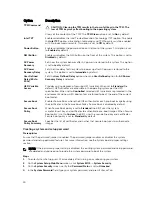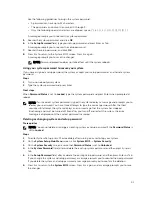
Option
Description
System
Manufacturer
Contact
Information
Specifies the contact information of the system manufacturer.
System CPLD
Version
Specifies the current version of the system complex programmable logic device
(CPLD) firmware.
UEFI Compliance
Version
Specifies the UEFI compliance level of the system firmware.
Memory Settings
You can use the
Memory Settings
screen to view all the memory settings and enable or disable specific
memory functions, such as system memory testing and node interleaving.
Viewing Memory Settings
To view the
Memory Settings
screen, perform the following steps:
1.
Turn on, or restart your system.
2.
Press F2 immediately after you see the following message:
F2 = System Setup
NOTE: If your operating system begins to load before you press F2, wait for the system to finish
booting, and then restart your system and try again.
3.
On the
System Setup Main Menu
screen, click
System BIOS
.
4.
On the
System BIOS
screen, click
Memory Settings
.
Memory Settings details
The
Memory Settings
screen details are explained as follows:
Option
Description
System Memory
Size
Specifies the memory size in the system.
System Memory
Type
Specifies the type of memory installed in the system.
System Memory
Speed
Specifies the system memory speed.
System Memory
Voltage
Specifies the system memory voltage.
Video Memory
Specifies the amount of video memory.
System Memory
Testing
Specifies whether the system memory tests are run during system boot. Options
are
Enabled
and
Disabled
. This option is set to
Disabled
by default.
Memory
Operating Mode
Specifies the memory operating mode. The options available are
Optimizer Mode
,
Advanced ECC Mode
,
Mirror Mode
,
Spare Mode
,
Spare with Advanced ECC Mode
,
Dell Fault Resilient Mode
and
Dell NUMA Fault Resilient Mode
. This option is set
to
Optimizer Mode
by default.
NOTE: The
Memory Operating Mode
option can have different default and
available options based on the memory configuration of your system.
43
















































